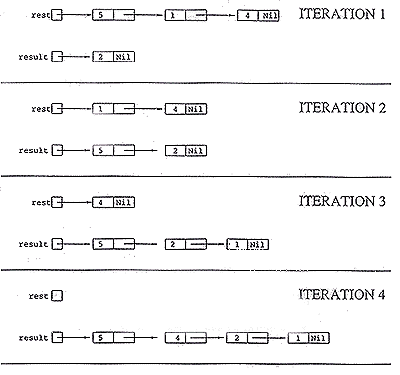| The question is concerned with the
implementation of a descending sort procedure that uses the insertion sort
algorithm. For example, sorting the sequence [7, 3, 2, 1, 9] produces [9, 7, 3, 2, 1]. The
definition of a linked list type, a prototype for the procedure Insert and the procedure InsertSort are given below. TYPE List = ^Node; PROCEDURE Insert(x: List; VAR xs: List); PROCEDURE InsertionSort(VAR xs: List); The procedure insert (to be defined later) takes a singleton list x and a sorted list xs as its arguments, and inserts the element stored in the singleton list into a sorted list such that the list xs remains in descending sorted order. For example, the figure below shows an example list before and after adding the singleton element 3:
|
||
| (a) | Informally describe the insertion sorting algorithm used in the Pascal procedure InsertionSort above. | [3] |
Three marks for an
adequate description of the algorithm. Award the marks as follows:
|
||
| (b) | Give the list [2, 5, 1, 4], draw four diagrams that show the states of the lists rest and result immediately after each execution of insert. | [8] |
| Two marks for each
correct diagram showing rest and result in the four stages below:
|
||
| (c) | How many list elements would have to be traversed by all the invocations of the insert procedure given: | |
| (i) an already sorted list of size N passed to InsertionSort? i.e., what is the worst case cost, or upper-bound complexiy of insertion sort? | [1] | |
| N2, or, O(N2)
|
||
| (ii) a list in descending order of values of size N passed to InsertionSort? i.e., what is the best case cost, or lower-bound complexity of insertion sort? | [1] | |
| N, or, O(N)
|
||
| (d) | Define the procedure Insert. | [7] |
| PROCEDURE Insert(x:
List; VAR xs: List); VAR temp, drag: List; BEGIN IF (xs = Nil) THEN xs:=x; ELSE IF (xs^.Item < x^.Item) THEN BEGIN x^.Next := xs; xs := x END ELSE BEGIN temp:=xs; drag:=Nil; WHILE ((temp <> Nil) AND (x^.Item < temp^.Item) DO BEGIN drag:=temp; temp:=temp^.Next END; x^.Next := temp; drag^.Next := x; END END;
No marks should be deducted for trivial syntactic errors. |
